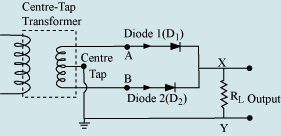
Well , the diagram might be a little complicated but it actually is not.
Now the speciality of the AC current is that its polarity changes (i.e. its terminals positive and negative switch places continuously) at an instant A is positive and B is negative and after some time B becomes positive and A becomes the negative terminals respectively.
Hence let us divide the whole function in two parts .
1. When A is the +ve part and B is the -ve part , in that case current will flow from A to B (positive to negative) , hence D1 becomes forward biased and D2 becomes reverse biased , therefore current will flow through D1 only and not D2 (ideal diodes has 0 resistance in forward biase and infinite resistance in reverse bias condition) , hence current flows in the load resistance R.
2. when A is negative and B is positive after a cycle current will flow from b to a (positive to negative) , hence D2 gets forward bias condition and D1 becomes in reverse bias condition, therefore current will flow from through D2 only and not in D1 and again current will flow through load resistance.
Hence as we see current flows through the load resestance in avary cycle (i.e. when A is +ve and B-ve and when Bis -ve and A is -ve) hence it is called full wave rectifier




